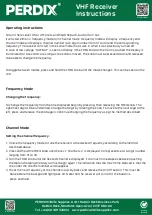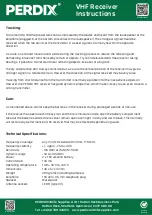
Tracking:
Turn around to find the proper direction as indicated by the diodes and heard from the loudspeaker or the
earphone (plugged in at the bottom, disconnects the loudspeaker). The strongest signal should be
received when the top points at the transmitter. A weaker signal is normally heard in the opposite
direction.
As a rule, one should move around a little during the tracking process to reduce the reflecting and
dampening influence from the nearby terrain or objects. Try to find elevated and free areas for taking
bearings, if possible. Do not stand near reflecting objects like a car or a big rock.
Theory and practice donʼt always coincide, but, as a rule the vertical position of the receiver may give a
stronger signal in a forested terrain. However, the direction of the signal received may be very false.
Tracking from short distance from the transmitter is normally a problem for the inexperienced person.
However, the PERDIX VHF receiver has good dynamic properties, which makes it easy to use even close to a
strong transmitter.
Care:
As mentioned above, do not keep the batteries in the receiver during prolonged periods of non-use.
If the receiver has been used in heavy rain and there is moisture inside, open the battery compartment,
take out the batteries and let the receiver remain open over night in a dry and warm place. This normally
will restore any performance of the receiver that may be affected by penetrating water.
Technical Specifications:
Frequency coverage
any 2 (4) MHz band within 138 - 175 MHz
Frequency stability
+/- 4ppm, -25 to +40°C
Sensitivity
-135 dBm at (S+N)/N=10dB
Dynamic range
-30 to -145 dBm
Power
2 x 1.5V alkaline battery
Current drain
140 mA
Operating temperature
from -35°C to +50°C
Dimensions
146 x 57 x 32 mm
Weight
390 grams (including batteries)
Earphone
150 ohm, 3.5 mm telephone plug
Speaker
Waterproof
Antenna sockets
LEMO (type 00)
VHF Receiver
Instructions
View Product
Please
Recycle
PERDIX Wildlife Supplies. Unit 1 Hatton Rock Business Park,
Hatton Rock, Stratford-Upon-Avon, CV37 0BX. UK
Tel: +44 (0)1789 336123 www.perdixwildlifesupplies.com
Visit our site






















